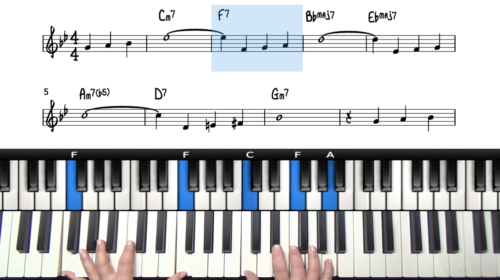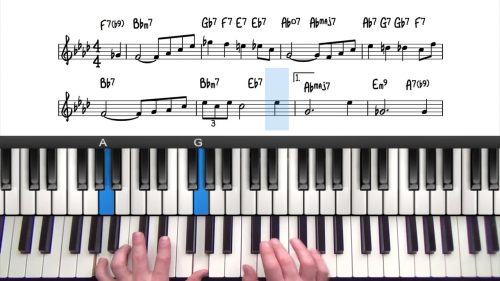Transitioning To The Bridge
In this lesson we will explore the B Section of “Misty”. Misty follows an AABA form and so we have 2 almost identical 8-bar A Sections, then an 8 bar B section with different harmony, and a final A section to finish.
Transition Fills & Options
We start by exploring harmonic techniques to help us transition from the 2nd A section into the Bridge. Looking at the lead sheet we have 2 full bars of Eb6 and we have a variety of ways that we can fill this space and transition smoothly into the B Section.
My favourite way to add some tension is to play the iv minor chord. This creates a mysterious, dark, and unexpected sound which then resolves back to Eb Major before moving into the bridge.
We also explore a V7 chord fill using a sus flavour and extend this further using a 1-6-2-5 progression with a descending inner voice. A final option is to play Eb6 to Ab- to Db7 and back to Eb6. We can also approach the Eb6 with Db6 to D6 which creates an extended version of the vi minor fill.
Voicings For The B Section
We explore voicing options for the B Section starting with simple 3-note voicings to help us to analyse the harmony and voice leading. We then introduce some more interesting voicings and a left hand stride style and similar to how we approached the A Section of the tune in the previous lessons.
Lesson Downloads
-
B Section Voicings Options File Type: pdf
Practice Tips
-
Study and memorise the different options for voicing the minor line cliché and we will revisit these in the module on improvisation.
-
Follow the guidance presented in the lesson on stride left hand and apply this to the bridge. Practice hands separately and put everything together once comfortable.
-
Spend some time on the 2nd line of the bridge which contains a new 25 progression (A-7 to D7). Learn the 3-note voicings to visualise the voice leading and then the extended voicing options.
-
Notice that the 3625 progression is also present at the end of the bridge to transition back to the final A section. Everything that we have covered so far in this course can be applied here.








Hi, Hayden, I have been going through this course in small chunks, making sure I totally absorb a lesson (or at times part of a lesson) before moving on to the next. It has been a gradual process but I am happy to say I have gotten A LOT out of the course so far. I know you put in a lot of thought and effort into it and wanted you to know it is very much appreciated and yes, it has been extremely useful.
By the way, in the I-VI-ii-V-I transition to the bridge (Eb, C7(b9), Fm7, Bb7(b9) and back to Eb, time stamp 6:25 to 6:38) I voiced the first Eb chord with the D or Maj7 on top rather than the Eb on top, and it sounded nice while also creating a 100 percent chromatic descent of the top note of the progression. This is not the best example I can give but thanks to your courses I have gained the confidence to try different voicings and while they don’t always work they often do in a pleasing way.
Looking forward to the rest of this course and the upcoming Nearness of You course.
Hi Humberto,
Thanks for the comment and I’m glad to hear you are finding the lessons useful.
Yes that’s a very good point with the descending chromatic line from the major 7 of the 1 chord, to the b9 of the V7 chord etc…
Remember that the 1 chord can also be substituted for the iii-3 chord, in this case G-7, and so the exact chromatic line that you outline can be used over G-7, to C7b9, to F (minor or major). It’s nice to understand that a principle like this can be applied in many different situations.
Yes I am making good progress with the new course on The Nearness Of You, and yes I will add some more lessons to this course on running and connecting scales.
Cheers,
Hayden
Just an addition to the previous comment on the I-VI-ii-V-! transition, I realize the melody note is Eb which would call for a voicing with the Eb on top on the initial I chord. But I found the D note pleasing as well.
Another option is just to play Eb first as the melody note before launching into the chord progression. This would not be strictly in time but it does not sound bad to me. Any comments/feedback on this appreciated.
Hi Humberto,
Yes you are correct that the melody note is Eb, but when playing solo jazz piano we have the creative freedom to change the melody (within reason). Ultimately, the melody note Eb is one of many notes that will work over that chord and so we can be creative and change the melody note, particularly when we are doing it to achieve something else, in this case the chromatic descending line over the 1-6-2-5 progression.
Whilst I say that we can change the melody notes as we like, it could be argued that the song should still be recognisable when we play it, and so that’s something to keep in mind. However, when improvising over the tune, we can choose any notes that we like, and so that chromatic sequence that you have identified is great material for creating our own improvised melodies.
I hope that helps Humberto and let me know if you have any further questions.
Cheers,
Hayden
Hayden, thanks greatly fpr your comments and feedback..
One more comment: The stride style seems to work quite well in the bridge and particulary when there are repeated eighth notes in the melody. On measure 22 I tried a D7#5#9 voicing, hitting D in the bass and then the left hand coming up to play F#, A#, C and E# (F). I liked the sound althogh I suspect not everyone would, and the top note in the chord voicing, the E# or F, seems to get the ear ready for the upcoming F note in the melody when the chord switches to the dominant F chord. Any thoughts on this voicing?
Hi Humberto,
Yes I also like to play the bridge of Misty with a stride left hand style. There is a lot of space in the melody and as you point point out also repeated notes, and so the left hand stride helps to keep the pulse and adds a little more movement and interest.
Regarding the D7#5#9 chord, yes it certainly works and it’s a nice voicing to play here to add some extra color and tension. It’s great that you are experimenting with the altered sounds. I mention in other lessons that we naturally gravitate towards certain alterations and combinations of alterations. As long as the alterations don’t clash with the melody note – in this case ‘D’ over the D7 chord – then we have the freedom to choose any alterations.
The #5#9 voicing is a good choice when we have the root in the melody. The #5#9 upper structure triad is a ‘major triad built off the #5’ which gives us the tones #5-R-#9 and so this fits perfectly with the root in the melody.
Above anything else always try the different altered voicings and UST options and follow your ears on which ones sound best to you. You will learn a lot in the process of trial and error and I find that this is the best way to learn which alterations work best in certain situations.
I hope that helps and any other questions just let me know.
Cheers,
Hayden
Hayden, as usual, thanks much for your comments and insights. Really like USTs, they help finding more complex voicings quickly.
Hi Haden, I’m having difficulty loading pianogoove pages. Sometimes takes minutes to load. Other sites load normally, I’m only having difficulties with your site. Any reason for this? I’ve tried other browsers.
Thanks for your help,
Michael
Hi Michael,
Thanks for letting me know and sorry to hear that you are having issues.
Please can you try accessing the website on mobile data ie. not your wifi, and let me know if the website is still slow to load?
That will tell us if the problem is specific to your wifi connection/IP address.
Please let me know the results and I will send the information to the developer.
Talk soon,
Hayden